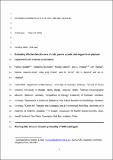Files in this item
Estimating effective detection area of static passive acoustic data loggers from playback experiments with cetacean vocalisations
Item metadata
| dc.contributor.author | Nuuttila, Hanna K. | |
| dc.contributor.author | Brundiers, Katharina | |
| dc.contributor.author | Dähne, Michael | |
| dc.contributor.author | Koblitz, Jens C. | |
| dc.contributor.author | Thomas, Len | |
| dc.contributor.author | Courtene-Jones, Winnie | |
| dc.contributor.author | Evans, Peter G. H. | |
| dc.contributor.author | Turner, John R. | |
| dc.contributor.author | Bennell, Jim D. | |
| dc.contributor.author | Hiddink, Jan G. | |
| dc.date.accessioned | 2019-10-21T23:36:21Z | |
| dc.date.available | 2019-10-21T23:36:21Z | |
| dc.date.issued | 2018-12 | |
| dc.identifier | 256302999 | |
| dc.identifier | 2f46d794-9fa5-46f0-93d7-c503f5871271 | |
| dc.identifier | 85055266277 | |
| dc.identifier | 000453591800005 | |
| dc.identifier.citation | Nuuttila , H K , Brundiers , K , Dähne , M , Koblitz , J C , Thomas , L , Courtene-Jones , W , Evans , P G H , Turner , J R , Bennell , J D & Hiddink , J G 2018 , ' Estimating effective detection area of static passive acoustic data loggers from playback experiments with cetacean vocalisations ' , Methods in Ecology and Evolution , vol. 9 , no. 12 , pp. 2362-2371 . https://doi.org/10.1111/2041-210X.13097 | en |
| dc.identifier.issn | 2041-210X | |
| dc.identifier.other | RIS: urn:47B806E50AE6ABCC2FD4E7104A9411B7 | |
| dc.identifier.other | ORCID: /0000-0002-7436-067X/work/54818845 | |
| dc.identifier.uri | https://hdl.handle.net/10023/18731 | |
| dc.description | The study was funded by the Federal Ministry for the Environment, Nature conservation and Nuclear Safety of Germany (FKZ: 0325238), Bangor University and supported by SeaMôr Wildlife Tours. | en |
| dc.description.abstract | 1. Passive acoustic monitoring (PAM) is used for many vocal species. However, few studies have quantified the fraction of vocalisations captured, and how animal distance and sound source level affect detection probability. Quantifying the detection probability or effective detection area (EDA) of a recorder is a prerequisite for designing and implementing monitoring studies, and essential for estimating absolute density and abundance from PAM data. 2. We tested the detector performance of cetacean click loggers (C-PODs) using artificial and recorded harbour porpoise clicks played at a range of distances and source levels. Detection rate of individual clicks and click sequences (or click trains) was calculated. A Generalised Additive Model (GAM) was used to create a detection function and estimate the effective detection radius (EDR) and EDA for both types of signals. 3. Source level and distance from logger influenced the detection probability. Whilst differences between loggers were evident, detectability was influenced more by the deployment site than within-logger variability. Maximum distance for detecting real recorded porpoise clicks was 566 m. Mean EDR for artificial signals with source level 176 dB re 1 μPa @ 1m was 187 m., and for a recorded vocalisation with source level up to 182 dB re 1 μPa was 188 m. For detections classified as harbour porpoise click sequences the mean EDR was 72 m. 4. The analytical methods presented are a valid technique for estimating the EDA of any logger used in abundance estimates. We present a practical way to obtain data with a cetacean click logger, with the caveat that artificial playbacks cannot mimic real animal behaviour and are at best able to account for some of the variability in detections between sites, removing logger and propagation effects so that what remains is density and behavioural differences. If calibrated against real-world EDAs (e.g., from tagged animals) it is possible to estimate site-specific detection area and absolute density. We highlight the importance of accounting for both biological and environmental factors affecting vocalisations so that accurate estimates of detection area can be determined, and effective monitoring regimes implemented. | |
| dc.format.extent | 712904 | |
| dc.language.iso | eng | |
| dc.relation.ispartof | Methods in Ecology and Evolution | en |
| dc.subject | Abundance | en |
| dc.subject | C-POD | en |
| dc.subject | Density estimation | en |
| dc.subject | Detection function | en |
| dc.subject | Effective detection radius | en |
| dc.subject | Static passive acoustic monitoring | en |
| dc.subject | QH301 Biology | en |
| dc.subject | GC Oceanography | en |
| dc.subject | DAS | en |
| dc.subject.lcc | QH301 | en |
| dc.subject.lcc | GC | en |
| dc.title | Estimating effective detection area of static passive acoustic data loggers from playback experiments with cetacean vocalisations | en |
| dc.type | Journal article | en |
| dc.contributor.institution | University of St Andrews. Statistics | en |
| dc.contributor.institution | University of St Andrews. School of Mathematics and Statistics | en |
| dc.contributor.institution | University of St Andrews. Marine Alliance for Science & Technology Scotland | en |
| dc.contributor.institution | University of St Andrews. Centre for Research into Ecological & Environmental Modelling | en |
| dc.identifier.doi | 10.1111/2041-210X.13097 | |
| dc.description.status | Peer reviewed | en |
| dc.date.embargoedUntil | 2019-10-22 |
This item appears in the following Collection(s)
Items in the St Andrews Research Repository are protected by copyright, with all rights reserved, unless otherwise indicated.

